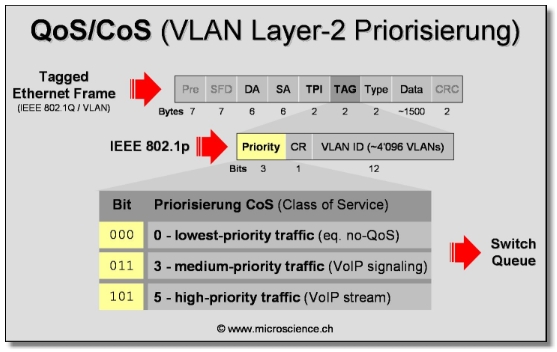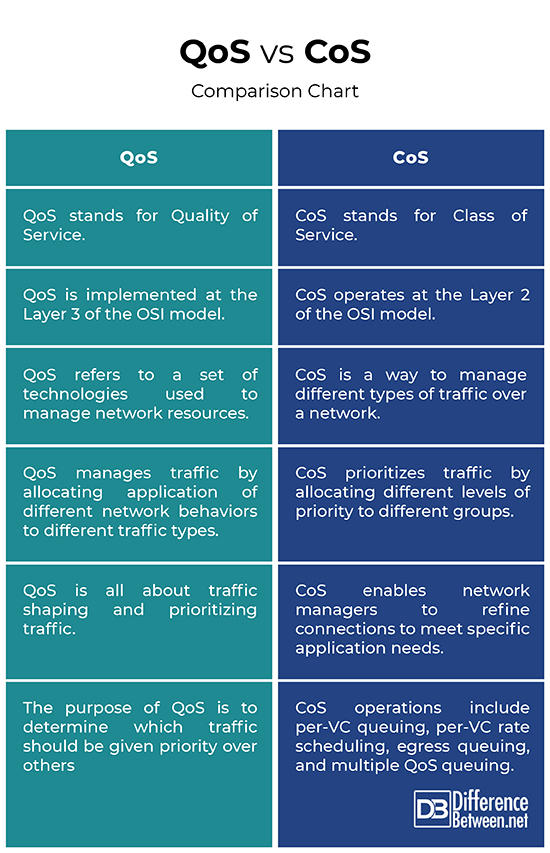Difference Between QoS and CoS
In today’s networks, it is common to find packet-oriented networks in which different types of traffic such as voice, video, and Internet share the same infrastructure and the same network resources. Such networks work well if there is enough CPU, bandwidth, and memory to handle all the packets traversing the network as they arrive. But, this is rarely the case these days. User-based contention occurs when packets from different users, departments or even groups try to use the same network resources. To avoid contention packets must be treated with managed unfairness. This is where QoS comes to the picture. QoS implies all packets are not equal, so it allows certain kinds of traffic to be given higher priority compared to other traffic. However, the term QoS is often used interchangeably with yet another similar term CoS.

What is Quality of Service (QoS)?
Quality of Service or QoS in the context of networking services refers to the set of technologies used to manage network resources by allocating application of different network behaviors to different traffic types. QoS is all about traffic shaping and prioritizing traffic. It specifies rules about which traffic has priority on your network. The concept of QoS is a little complex because it is structurally different from other concepts found in the networking world. QoS is not a standalone service or product but rather a concept that allows for allocation of network resources for important applications or traffic. It allows the network to include a system of “managed unfairness.” This concept of unfairness applies equally to traffic for which higher levels of priority must be maintained and traffic that is undesirable in the network. QoS is defined as the measure of a system’s service availability and transmission quality.

What is Class of Service (CoS)?
Class of Service or CoS is a way to manage different types of traffic over a network by dividing similar types of traffic by classes. CoS is sometimes used to refer to the Layer 2 QoS capabilities provided by Ethernet or ATM. However, the term is used purely in the context of traffic classification as a set of traffic streams that will have common applications applied to them. Hence, the term CoS is used to refer to the classification of an aggregate traffic stream into a number of constituent classes, where different actions are applied to each individual class of service. It prioritizes traffic by allocating different levels of priority to different groups. For example, it can give more priority to the voice traffic over others such as email or HTTP traffic. This enables network managers to refine connections to meet specific application needs. The role of CoS includes operations such as per-VC queuing, per-VC rate scheduling, egress queuing, and multiple QoS queuing.
Difference between QoS and CoS
Meaning
– QoS, short for Quality of Service, in the context of networking refers to a set of technologies used to manage network resources by allocating application of different network behaviors to different traffic types. It manages traffic on a network in order to reduce packet loss, latency and jitter on the network. CoS, short for Class of Service is a way to manage different types of traffic over a network by dividing similar types of traffic by classes. CoS prioritizes traffic by allocating different levels of priority to different groups while QoS manipulates traffic according to these set priority levels.
Concept
– QoS is defined as the measure of a system’s service availability and transmission quality. QoS is not a standalone service or product but rather a concept that allows for allocation of network resources for important applications or traffic. QoS is all about traffic shaping and prioritizing traffic. CoS, on the other hand, defines priority levels and is used by the QoS to differentiate and monitor network traffic. When a network congestion and delay occurs, some data packets must be prioritized to avoid loss of data. CoS defines the protocols to manage multiple traffic profiles by dividing similar traffic types into classes and then applying different levels of priority to each class.
Purpose
– The fundamental purpose of QoS is to determine which traffic should be given priority over others and access to the link. It allows certain kinds of traffic to be given higher priority compared to other traffic. Once traffic is classified, the highest priority traffic can be sent first, while the traffic with lowest priority goes in a queue. CoS enables network managers to refine connections to meet specific application needs. The role of CoS includes operations such as per-VC queuing, per-VC rate scheduling, egress queuing, and multiple QoS queuing.
QoS vs. CoS: Comparison Chart

Summary
QoS refers to all the tools that ensure high priority applications that require real time data get sufficient dedicated bandwidth and preference over other low priority applications. Networks without QoS are described as best-effort networks, which treat all packets as equally important. However, to obtain the appropriate levels of service from often scarce network resources, the fundamental concept of QoS must be applied – it suggests not all packets are created equal. The role of QoS is to allow the application of different network behaviors to different traffic types. CoS is a way to manage different types of traffic over a network by dividing similar types of traffic by classes.
- Difference Between Caucus and Primary - June 18, 2024
- Difference Between PPO and POS - May 30, 2024
- Difference Between RFID and NFC - May 28, 2024
Search DifferenceBetween.net :
Leave a Response
References :
[0]Barreiros, Miguel and Peter Lundqvist. QOS-Enabled Networks: Tools and Foundations. New Jersey, United States: John Wiley & Sons, 2016. Print
[1]Szigeti, Tim and Christina Hattingh. End-to-end Qos Network Design. Indiana, United States: CISCO Press, 2005. Print
[2]Evans, John W. and Clarence Filsfils. Deploying IP and MPLS QoS for Multiservice Networks: Theory and Practice. Amsterdam, Netherlands: Elsevier, 2010. Print
[3]Donahue, Gary A. Network Warrior: Everything You Need to Know That Wasn't on the CCNA Exam. California, United States: O'Reilly Media, Inc., 2011. Print
[4]Davies, Guy. Designing and Developing Scalable IP Networks. New Jersey, United States: John Wiley & Sons, 2004. Print
[5]Image credit: https://de.wikipedia.org/wiki/Datei:Voip_cos.jpg
[6]Image credit: https://en.wikipedia.org/wiki/File:Mod_qos_usecase1.gif
